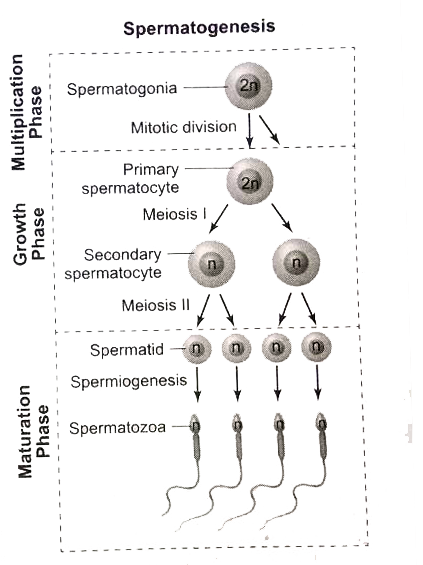InterviewSolution
Saved Bookmarks
| 1. |
Question : Explain the process of spermatogenesis with diagram. |
Answer» SOLUTION :Spermatogenesis is the sequence of eventsSpermatogenesis in the seminiferous tubules of the testes that produce the male gametes, the sperms. During development, the primordial germ cells migrate into the testes and becomeimmature germ cells called sperm mothercells or spermatogonia in the inner surfaces of spermatocyte the seminiferous tubules. The spermatogoniabegin to undergo mitotic division at puberty and continue throughout life. In the firststage of spermatogenesis, the spermatogonia migrate among sertoli cells towards the central lumen of the seminiferous tubule and become modified and enlarged to formprimary spermatocytes which are diploid with23 pairs i.e., 46 chromosomes. Some of the primary spermatocytes undergo first meioticdivision to form two secondary spermatocytes which are haploid with 23 chromosomes each. The secondary spermatocytes undergo second meiotic division to produce four haploid spermatids. The spermatids are transformed into maturepermatozoa (sperms) by the process called SPERMIOGENESIS. Sperms are finally released into the cavity of seminiferous tubules by a process called spermiation.  The whole process of spermatogenesis takes about 64 days. At any given time, different regions of the seminiferous tubules contain spermatocytes in different stages of development. The sperm production remains nearly constant at a rate of about 200 million sperms PER day. Spermatogenesis starts at the age of puberty and is initiated due to the increase in the release of Gonadotropin Releasing Hormone (GnRH) by the hypothalamus. GnRH acts on the anterior pituitary gland and stimulates the secretion of two gonadotropins namely Follicle Stimulating Hormone (FSH) and Lutenizing Hormone (LH). FSH stimulates testicular growth and enhances the production of Androgen Binding Protein (ABP) by the sertoli cells and helps in the process of spermiogenesis. LH acts on the Leydig cells and stimulates the synthesis of testosterone which in turn stimulates the process of spermatogenesis. |
|